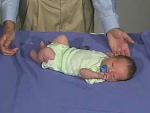Neural Exam - Newborn tone - resting posture: Difference between revisions
From Embryology
No edit summary |
mNo edit summary |
||
| (4 intermediate revisions by 2 users not shown) | |||
| Line 1: | Line 1: | ||
{| border='0px' | {| border='0px' | ||
|- | |- | ||
| < | | <html5media height="300" width="320">File:Newborn n 03.mp4</html5media> | ||
| valign="top" |This 5-day-old infant is in the alert, quiet state. | | valign="top" |[[File:Newborn n 03.jpg|right|150px]]This 5-day-old infant is in the alert, quiet state. | ||
* For a term newborn the resting posture is [[F#flexion|flexion]] of the extremities with the extremities closely adducted to the trunk. | * For a term newborn the resting posture is [[F#flexion|flexion]] of the extremities with the extremities closely adducted to the trunk. | ||
* After the first few days of life, the extremities are still predominantly in the flexed position but they are not as tightly adducted as they are in the first 48 hours of life. | * After the first few days of life, the extremities are still predominantly in the flexed position but they are not as tightly adducted as they are in the first 48 hours of life. | ||
| Line 10: | Line 10: | ||
|- | |- | ||
|} | |} | ||
---- | |||
{{Template:Newborn NeuroExam}} | |||
{{Template:PediNeuroLogic Exam}} | {{Template:PediNeuroLogic Exam}} | ||
[[Category:Human Neonatal]] | [[Category:Human Neonatal]] | ||
Latest revision as of 19:06, 19 June 2014
| <html5media height="300" width="320">File:Newborn n 03.mp4</html5media> | This 5-day-old infant is in the alert, quiet state.
|
- Neural Exam Movies: normal behaviour | cranial nerves | Newborn Tone - resting posture | upper extremity | arm traction | arm recoil | scarf sign | hand position | lower extremity | leg traction | leg recoil | popliteal angle | heel to ear | neck tone | head lag | head control | Newborn Positions - prone | ventral suspension | vertical suspension | Newborn Reflexes - deep tendon reflexes | plantar reflex | suck, root | Moro | Galant | stepping | grasp | Newborn Head - head shape and sutures | head circumference | Neonatal Diagnosis
| Movie Source - Paul D. Larsen |
|---|
| Movies from the PediNeuroLogic Exam website are used by permission of Paul D. Larsen, M.D., University of Nebraska Medical Center and Suzanne S. Stensaas, Ph.D., University of Utah School of Medicine. Additional materials were drawn from resources provided by Alejandro Stern, Stern Foundation, Buenos Aires, Argentina; Kathleen Digre, M.D., University of Utah; and Daniel Jacobson, M.D., Marshfield Clinic, Wisconsin. The movies are licensed under a Creative Commons Attribution-NonCommerical-ShareAlike 2.5 License. |
| Links: Neural Exam Movies | Movies |
Cite this page: Hill, M.A. (2024, April 18) Embryology Neural Exam - Newborn tone - resting posture. Retrieved from https://embryology.med.unsw.edu.au/embryology/index.php/Neural_Exam_-_Newborn_tone_-_resting_posture
- © Dr Mark Hill 2024, UNSW Embryology ISBN: 978 0 7334 2609 4 - UNSW CRICOS Provider Code No. 00098G
